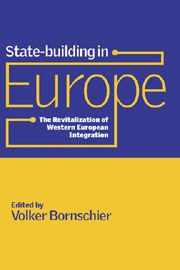Book contents
- Frontmatter
- Contents
- List of figures and tables
- List of contributors
- Preface
- Acknowledgements
- Part I State-building and Political Entrepreneurship
- Part II The Core Elements in Recasting the European Bargain
- Part III Conclusions beyond the Single European Act of 1986
- Appendix List of interview partners
- Bibliography
- Index
Part II - The Core Elements in Recasting the European Bargain
Published online by Cambridge University Press: 10 October 2009
- Frontmatter
- Contents
- List of figures and tables
- List of contributors
- Preface
- Acknowledgements
- Part I State-building and Political Entrepreneurship
- Part II The Core Elements in Recasting the European Bargain
- Part III Conclusions beyond the Single European Act of 1986
- Appendix List of interview partners
- Bibliography
- Index
Summary
Without doubt, the internal market programme was the core element in recasting the European bargain with the Single European Act of 1986. Chapter 3 by Nicola Fielder reports the findings from analysing the relevant documents and from interviewing protagonists, witnesses and experts (see list of interview partners in the appendix to this volume). How energetically the Commission pushed the internal market and how vigorously the European Roundtable of Industrialists demanded it is clearly revealed by the empirical evidence. Chapter 3 points not only to the mutually reinforcing constellation at this transnational and supranational level, but also to the linkages between national and supranational levels in explaining the decisive events of the mid-1980s. The evidence for the latter – which has already been suggested in the literature – thus slightly modifies our original hypothesis.
The European proposals for technology corporatism are researched in more detail in chapter 4 by Simon Parker. From this it becomes evident that these initiatives go back to the late 1970s and also that the resulting new procedures clearly pre-date the Single European Act, which, however, included the by then established new praxis into Community law. The finding of a certain post-SEA disintegration of the alliance between the Commission and the Information Technology Roundtable is worth mentioning. We will come back to this when we deal with developments in a later period (see Part III).
The internal market as well as European technology corporatism were obvious manifestations of elite bargains between the Commission and the various Roundtables.
- Type
- Chapter
- Information
- State-building in EuropeThe Revitalization of Western European Integration, pp. 73 - 74Publisher: Cambridge University PressPrint publication year: 2000



